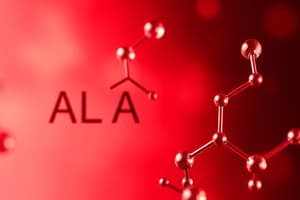Podcast
Questions and Answers
What is the general formula for alkanes?
What is the general formula for alkanes?
- CnH2n
- CnHn+1
- CnHn-1
- CnH2n+2 (correct)
What is a characteristic of alkanes based on their physical properties?
What is a characteristic of alkanes based on their physical properties?
- They have high boiling points.
- They have a density greater than that of water.
- They are non-polar and have low boiling points. (correct)
- They are soluble in water.
What type of reaction do alkanes undergo where a hydrogen atom is replaced by another atom or group?
What type of reaction do alkanes undergo where a hydrogen atom is replaced by another atom or group?
- Combustion reaction
- Oxidation reaction
- Substitution reaction (correct)
- Cracking reaction
What is an example of an alkane that is commonly found in gasoline?
What is an example of an alkane that is commonly found in gasoline?
What type of isomerism can alkanes exhibit?
What type of isomerism can alkanes exhibit?
Flashcards are hidden until you start studying
Study Notes
Alkanes
Definition
- Alkanes are a type of saturated hydrocarbon, meaning they have only single bonds between carbon atoms.
- They are also known as paraffins or saturated hydrocarbons.
General Formula
- The general formula for alkanes is CnH2n+2, where n is the number of carbon atoms.
Nomenclature
- Alkanes are named using the IUPAC system, which follows these rules:
- The parent chain is the longest continuous chain of carbon atoms.
- The parent chain is numbered starting from the end that is closest to a branch.
- Branches are named as substituents and are numbered based on their position on the parent chain.
- The suffix "-ane" is used to indicate that the molecule is an alkane.
Physical Properties
- Alkanes are non-polar and have low boiling points, which increase as the number of carbon atoms increases.
- They are insoluble in water and have a density less than that of water.
Chemical Properties
- Alkanes are relatively unreactive, except for combustion reactions.
- They undergo substitution reactions, where a hydrogen atom is replaced by another atom or group.
- They also undergo cracking reactions, where a large alkane is broken down into smaller ones.
Examples
- Methane (CH4) is the simplest alkane.
- Ethane (C2H6) is another example of an alkane.
- Octane (C8H18) is a common alkane found in gasoline.
Isomerism
- Alkanes can exhibit structural isomerism, where the same molecular formula has different bond arrangements.
- For example, butane (C4H10) has two structural isomers: n-butane and isobutane.
Alkanes
- Alkanes are saturated hydrocarbons with only single bonds between carbon atoms, also known as paraffins or saturated hydrocarbons.
General Formula and Structure
- The general formula for alkanes is CnH2n+2, where n is the number of carbon atoms.
Nomenclature
- Alkanes are named using the IUPAC system, with rules including:
- Identifying the longest continuous chain of carbon atoms as the parent chain
- Numbering the parent chain starting from the end closest to a branch
- Naming branches as substituents and numbering based on their position
- Using the suffix "-ane" to indicate an alkane
Physical Properties
- Alkanes are non-polar and have low boiling points that increase with the number of carbon atoms
- They are insoluble in water and have a density less than that of water
Chemical Properties
- Alkanes are relatively unreactive, except for combustion reactions
- They undergo substitution reactions, where a hydrogen atom is replaced by another atom or group
- They also undergo cracking reactions, where a large alkane is broken down into smaller ones
Examples
- Methane (CH4) is the simplest alkane
- Ethane (C2H6) is another example of an alkane
- Octane (C8H18) is a common alkane found in gasoline
Isomerism
- Alkanes can exhibit structural isomerism, where the same molecular formula has different bond arrangements
- For example, butane (C4H10) has two structural isomers: n-butane and isobutane
Studying That Suits You
Use AI to generate personalized quizzes and flashcards to suit your learning preferences.



